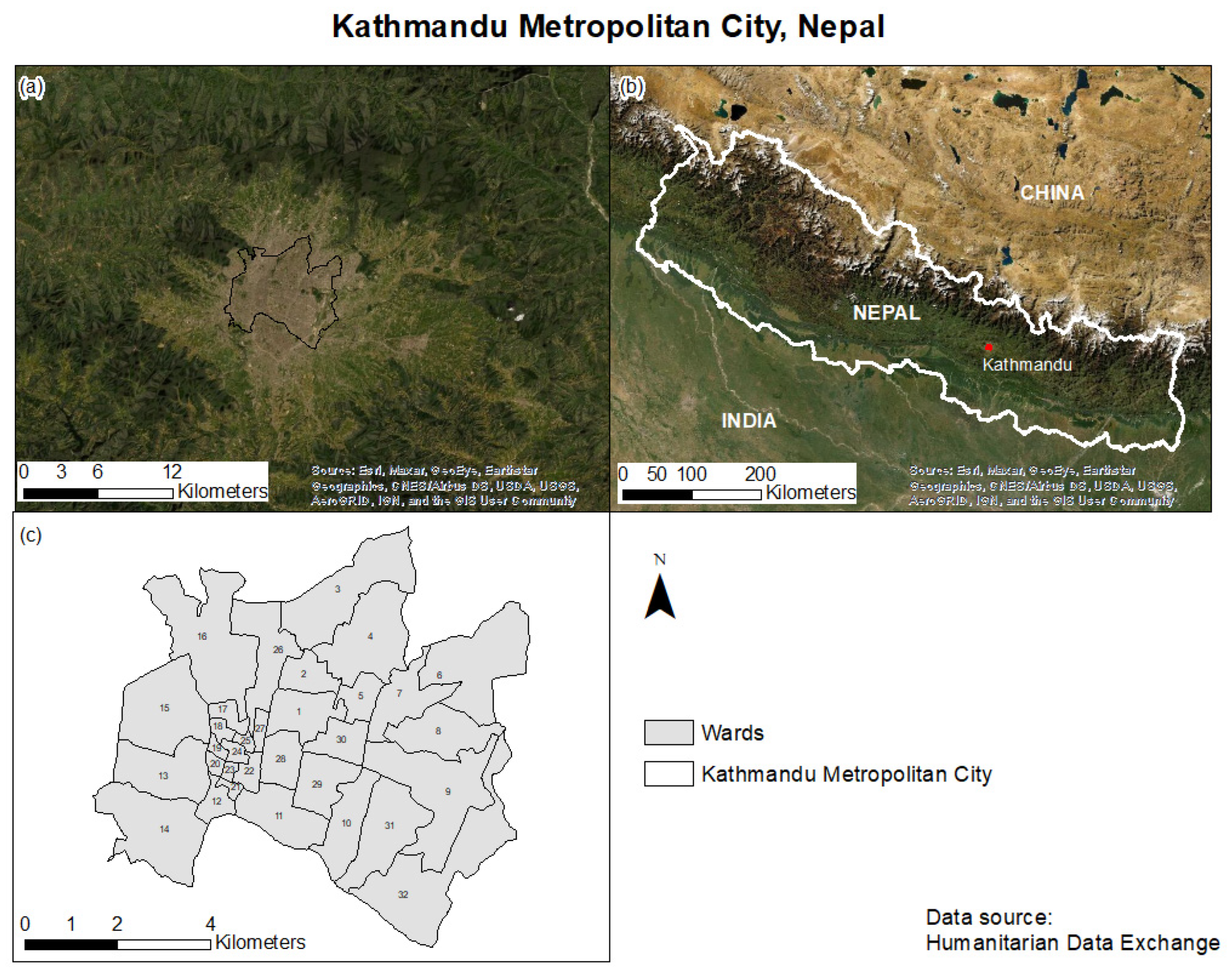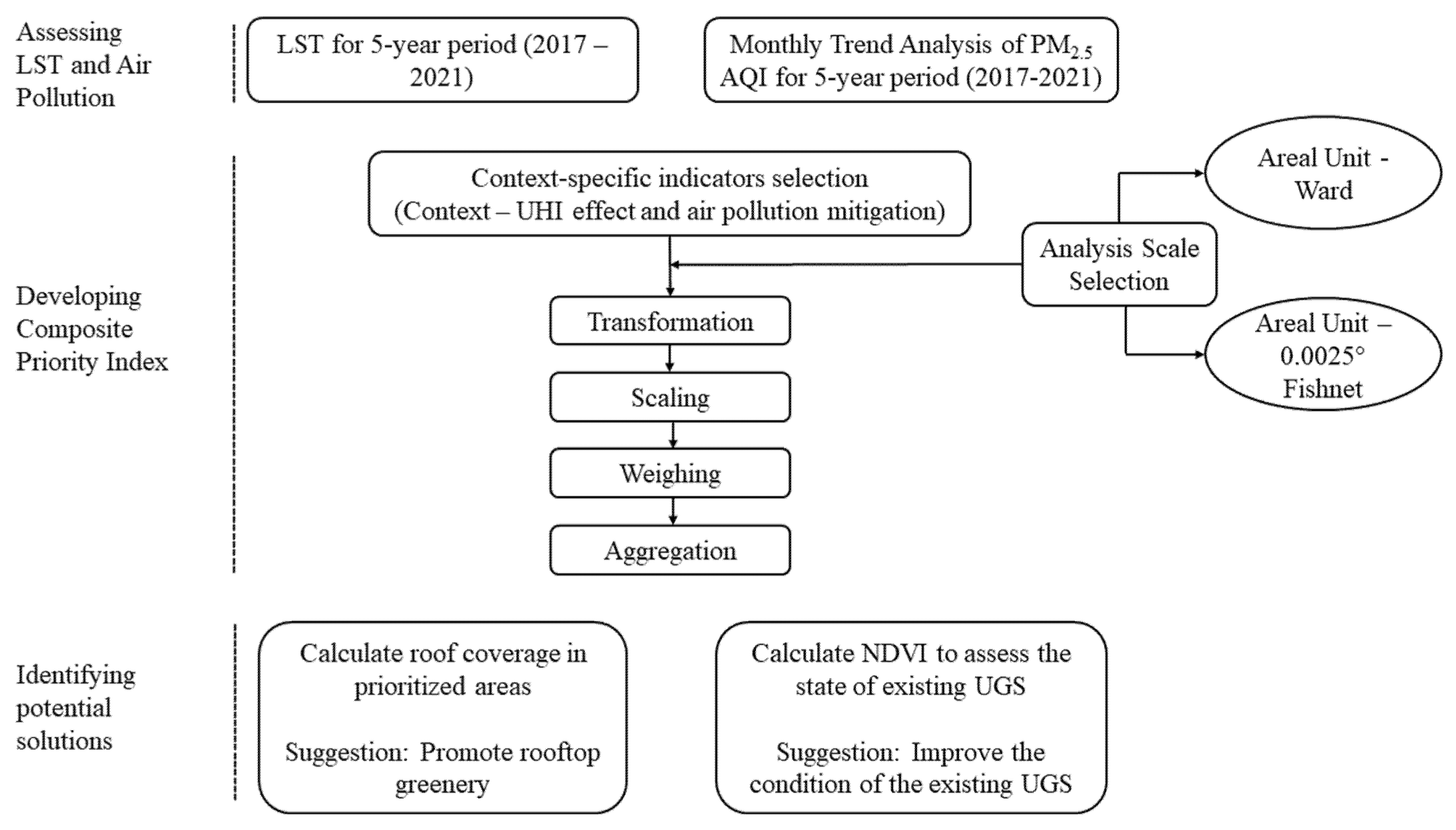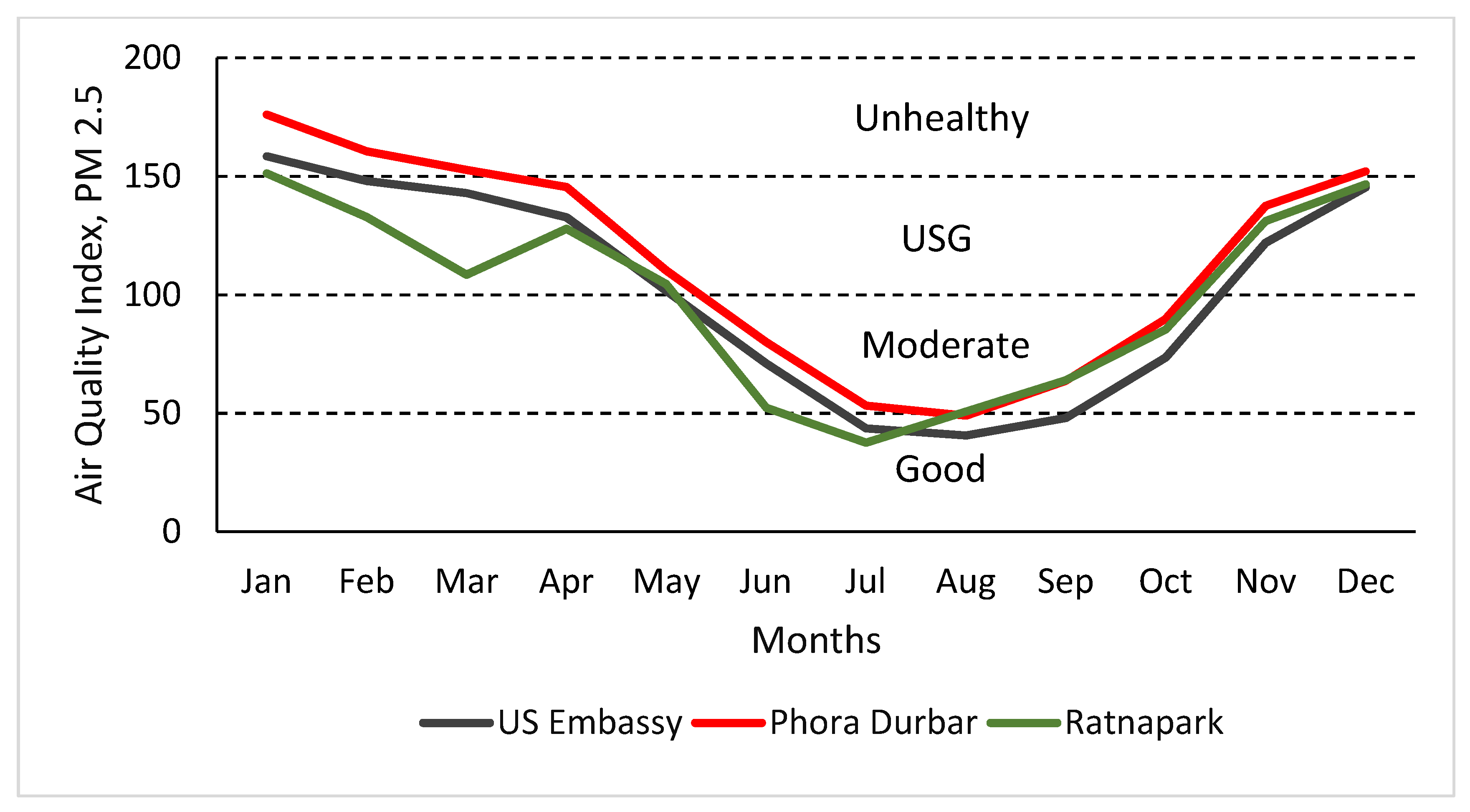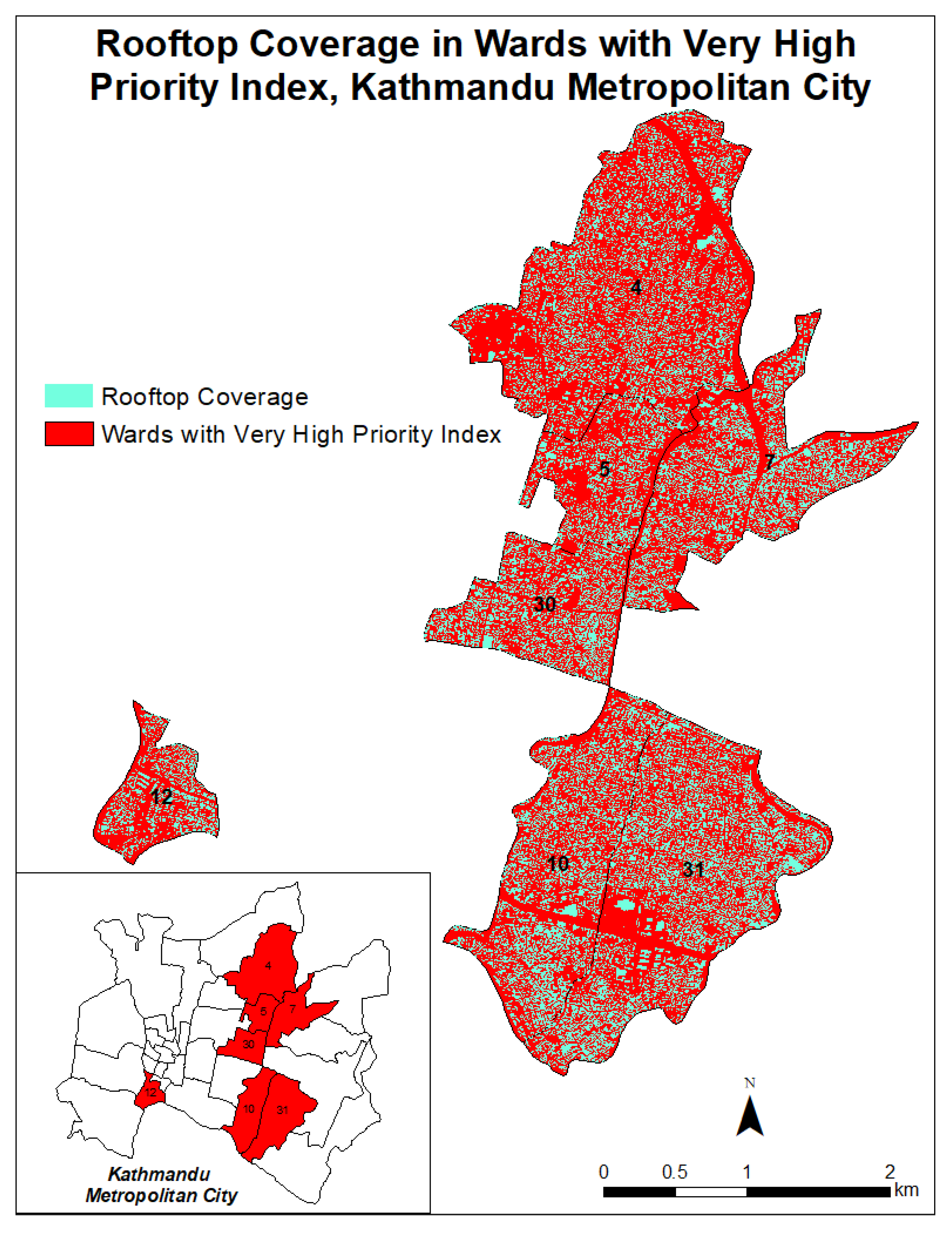Urban Green Space Prioritization to Mitigate Air Pollution and the Urban Heat Island Effect in Kathmandu Metropolitan City, Nepal
Abstract
:1. Introduction
1.1. Air Pollution in KMC
1.2. Urban Heat Island (UHI) in KMC
1.3. Role of UGS in Mitigating Air Pollution and the UHI Effect
2. Materials and Methods
2.1. Assessing LST and Air Pollution in KMC
2.2. Developing Composite Priority Index
2.3. Identifying Potential Solutions
3. Results
4. Discussion
5. Conclusions
Author Contributions
Funding
Institutional Review Board Statement
Informed Consent Statement
Data Availability Statement
Acknowledgments
Conflicts of Interest
References
- Khanal, N.; Uddin, K.; Matin, M.A.; Tenneson, K. Automatic detection of spatiotemporal urban expansion patterns by fusing OSM and Landsat data in Kathmandu. Remote Sens. 2019, 11, 2296. [Google Scholar] [CrossRef] [Green Version]
- Ishtiaque, A.; Shrestha, M.; Chhetri, N. Rapid urban growth in the Kathmandu Valley, Nepal: Monitoring land use land cover dynamics of a himalayan city with Landsat imageries. Environments 2017, 4, 72. [Google Scholar] [CrossRef]
- Saud, B.; Paudel, G. The Threat of Ambient Air Pollution in Kathmandu, Nepal. J. Environ. Public Health 2018, 2018, 1–7. [Google Scholar] [CrossRef] [PubMed] [Green Version]
- Sarif, O.; Rimal, B.; Stork, N.E. Assessment of changes in land use/land cover and land surface temperatures and their impact on surface Urban heat Island phenomena in the Kathmandu Valley (1988–2018). ISPRS Int. J. Geo-Inf. 2020, 9, 726. [Google Scholar] [CrossRef]
- WHO. Air Pollution. 2022. Available online: https://www.who.int/health-topics/air-pollution#tab=tab_1 (accessed on 8 July 2022).
- Gautam, S.P.; Silwal, A.; Poudel, P.; Thapa, A.; Sharma, P.; Lamsal, M.; Neupane, R. Comparative Study of Ambient Air Quality Using Air Quality Index in Kathmandu City, Nepal. IOSR J. Environ. Sci. Toxicol. Food Technol. 2020, 14, 29–35. [Google Scholar] [CrossRef]
- Gurung, A.; Son, J.-Y.; Bell, M.L. Particulate matter and risk of hospital admission in the Kathmandu Valley, Nepal: A case-crossover study. Am. J. Epidemiol. 2017, 186, 573–580. [Google Scholar] [CrossRef] [Green Version]
- Cohen, A.J.; Brauer, M.; Burnett, R.; Anderson, H.R.; Frostad, J.; Estep, K.; Balakrishnan, K.; Brunekreef, B.; Dandona, L.; Dandona, R.; et al. Estimates and 25-year trends of the global burden of disease attributable to ambient air pollution: An analysis of data from the Global Burden of Diseases Study 2015. Lancet 2017, 389, 1907–1918. [Google Scholar] [CrossRef] [Green Version]
- Karki, K.B.; Dhakal, P.; Shrestha, S.L.; Joshi, H.D.; Aryal, K.K.; Poudyal, A.; Puri, S.; Verma, S.C.; Pokhrel, A.; Lohani, G.R.; et al. Situation Analysis of Ambient Air Pollution and Respiratory Effects in Kathmandu Valley, 2015; Nepal Health Research Council: Kathmandu, Nepal, 2016; pp. 1–234. [Google Scholar]
- Gurung, A.; Bell, M.L. The state of scientific evidence on air pollution and human health in Nepal. Environ. Res. 2013, 124, 54–64. [Google Scholar] [CrossRef]
- Manandhar, S. Environmental Activist Demand Prompt Action to Improve Kathmandu’s Air Quality; The Kathmandu Post: Kathmandu, Nepal, 2021. [Google Scholar]
- Rives, R.M. Assessing Changes in Actual Air Quality and Public Perceptions of Air Quality in Kathmandu Valley Nepal pre and post COVID-19 Lockdown. Master’s Thesis, University of South Florida, Tampa, FL, USA, 2022. [Google Scholar]
- Magar, S.G. Kathmandu’s Air Quality the Worst in the World. Onlinekhabar. 2021. Available online: https://english.onlinekhabar.com/kathmandus-air-quality-the-worst-in-the-world.html (accessed on 28 May 2022).
- Sharma, G. Nepal Battles Worst Forest Fires in Years as Air Quality Drops. Reuters. 2021. Available online: https://www.reuters.com/world/china/nepal-battles-worst-forest-fires-years-air-quality-drops-2021-04-09/ (accessed on 28 May 2022).
- Aljazeera. Nepal Closes Schools as Air Pollution Hits Alarming Levels. 2021. Available online: https://www.aljazeera.com/news/2021/3/30/nepal-closes-schools-as-air-pollution-hits-alarming-levels (accessed on 30 July 2022).
- Aryal, A.; Shakya, B.M.; Maharjan, M.; Talchabhadel, R.; Thapa, B.R. Evaluation of the Land Surface Temperature using Satellite Images in Kathmandu Valley. Nepal J. Civ. Eng. 2021, 1, 1–10. [Google Scholar] [CrossRef]
- Magar, D.S.; Magar, R.K.S.; Chidi, C.L. Assessment of urban heat island in Kathmandu valley (1999–2017). Geogr. J. Nepal 2021, 14, 1–20. [Google Scholar] [CrossRef]
- Stewart, I.D. A systematic review and scientific critique of methodology in modern urban heat island literature. Int. J. Climatol. 2011, 31, 200–217. [Google Scholar] [CrossRef]
- Rim, C.-S. The effects of urbanization, geographical and topographical conditions on reference evapotranspiration. Clim. Chang. 2009, 97, 483–514. [Google Scholar] [CrossRef]
- Hu, Y.; Jia, G.; Pohl, C.; Zhang, X.; van Genderen, J. Assessing surface albedo change and its induced radiation budget under rapid urbanization with Landsat and GLASS data. Theor. Appl. Climatol. 2016, 123, 711–722. [Google Scholar] [CrossRef]
- Kennedy, C.; Steinberger, J.; Gasson, B.; Hansen, Y.; Hillman, T.; Havránek, M.; Pataki, D.; Phdungsilp, A.; Ramaswami, A.; Mendez, G.V. Greenhouse gas emissions from global cities. Environ. Sci. Technol. 2009, 43, 7297–7302. [Google Scholar] [CrossRef]
- Opoku, E.E.O.; Boachie, M.K. The environmental impact of industrialization and foreign direct investment. Energy Policy 2020, 137, 111178. [Google Scholar] [CrossRef]
- Heaviside, C.; Macintyre, H.; Vardoulakis, S. The Urban Heat Island: Implications for Health in a Changing Environment. Curr. Environ. Health Rep. 2017, 4, 296–305. [Google Scholar] [CrossRef]
- Alfraihat, R.; Mulugeta, G.; Gala, T.S. Ecological Evaluation of Urban Heat Island in Chicago City, USA. J. Atmos. Pollut. 2016, 4, 23–29. [Google Scholar] [CrossRef]
- Ningrum, W. Urban Heat Island towards Urban Climate. IOP Conf. Ser. Earth Environ. Sci. 2018, 118, 012048. [Google Scholar] [CrossRef]
- Wong, K.V.; Paddon, A.; Jimenez, A. Review of World Urban Heat Islands: Many Linked to Increased Mortality. J. Energy Resour. Technol. 2013, 135, 022101. [Google Scholar] [CrossRef]
- Bernardo, L.M.; Crane, P.A.; Veenema, T.G. Treatment and prevention of pediatric heat-related illnesses at mass gatherings and special events. Dimens. Crit. Care Nurs. 2006, 25, 165–171. [Google Scholar] [CrossRef]
- Bouchama, A.; Knochel, J.P. Heat stroke. N. Engl. J. Med. 2002, 346, 1978–1988. [Google Scholar] [CrossRef] [PubMed]
- Priyadarsini, R. Urban heat island and its impact on building energy consumption. Adv. Build. Energy Res. 2009, 3, 261–270. [Google Scholar] [CrossRef]
- Bhargava, A.; Lakmini, S.; Bhargava, S. Urban Heat Island Effect: It’s Relevance in Urban Planning. J. Biodivers. Endanger. Species 2017, 5, 1–4. [Google Scholar] [CrossRef]
- Lorenzini, G.; Pellegrini, E.; Campanella, A.; Nali, C. It’s not just the heat and the drought: The role of ozone air pollution in the 2012 heat wave. Agrochimica 2014, 58, 40–52. [Google Scholar] [CrossRef]
- Zupancic, T.; Westmacott, C.; Bulthuis, M. The Impact of Green Space on Heat and Air Pollution in Urban Communities: A Meta-Narrative Systematic Review; David Suzuki Foundation: Vancouver, BC, Canada, 2015; Available online: https://policycommons.net/artifacts/1202600/the-impact-of-green-space-on-heat-and-air-pollution-in-urban-communities/1755709/ (accessed on 12 August 2022).
- Smith, W.H. Air Pollution and Forests: Interactions Between Air Contaminants and Forest Ecosystems; Springer: New York, NY, USA, 2012. [Google Scholar]
- Nowak, D.J.; Crane, D.E.; Stevens, J.C. Air pollution removal by urban trees and shrubs in the United States. Urban For. Urban Green. 2006, 4, 115–123. [Google Scholar] [CrossRef]
- Taha, H. Modeling impacts of increased urban vegetation on ozone air quality in the South Coast Air Basin. Atmos. Environ. 1996, 30, 3423–3430. [Google Scholar] [CrossRef]
- Bowler, D.; Buyung-Ali, L.; Knight, T.; Pullin, A. How Effective is ‘Greening’ of Urban Areas in Reducing Human Exposure to Ground Level Ozone Concentrations, UV Exposure and the ‘Urban Heat Island Effect’? Available online: www.environmentalevidence.org/SR41.html (accessed on 12 August 2022).
- McGinn, C.E. The Microclimate and Energy Use in Suburban Tree Canopies (California). Ph.D. Thesis, University of California, Davis, CA, USA, 1982. [Google Scholar]
- Heisler, G.M. Energy savings with trees. J. Arboric. 1986, 12, 113–125. [Google Scholar] [CrossRef]
- Loughner, C.P.; Allen, D.J.; Zhang, D.-L.; Pickering, K.E.; Dickerson, R.R.; Landry, L. Roles of urban tree canopy and buildings in urban heat island effects: Parameterization and preliminary results. J. Appl. Meteorol. Climatol. 2012, 51, 1775–1793. [Google Scholar] [CrossRef]
- Akbari, H.; Kurn, D.M.; Bretz, S.E.; Hanford, J.W. Peak power and cooling energy savings of shade trees. Energy Build. 1997, 25, 139–148. [Google Scholar] [CrossRef] [Green Version]
- Gautam, D.R. Air pollution: Its causes & consequences with reference to Kathmandu Metropolitan City. Third Pole 2010, 8, 27–33. [Google Scholar]
- Baniya, B.; Techato, K.; Ghimire, S.K.; Chhipi-shrestha, G. A Review of Green Roofs to Mitigate Urban Heat Island and Kathmandu Valley in Nepal. Appl. Ecol. Environ. Sci. 2018, 6, 137–152. [Google Scholar] [CrossRef]
- Shrestha, S.; Baral, B.; Dhital, N.B.; Yang, H.H. Assessing air pollution tolerance of plant species in vegetation traffic barriers in Kathmandu Valley, Nepal. Sustain. Environ. Res. 2021, 31, 1–9. [Google Scholar] [CrossRef]
- Kanwar, K.; Dhamala, M.K.; Maskey-Byanju, R. Air pollution tolerance index: An approach towards the effective green belt around Kathmandu metropolitan city, Nepal. Nepal J. Environ. Sci. 2016, 4, 23–29. [Google Scholar] [CrossRef] [Green Version]
- U.S. Geological Survey. Landsat 8-9 OLI/TIRS Collection 2 Level 2. 2017. Available online: https://earthexplorer.usgs.gov/ (accessed on 25 April 2022).
- World Air Quality Project. Air Quality Historical Data. 2022. Available online: https://aqicn.org/data-platform/register/ (accessed on 10 June 2022).
- US EPA. Particulate Matter (PM2.5) Trends. United States Environmental Protection Agency. 2022. Available online: https://www.epa.gov/air-trends/particulate-matter-pm25-trends (accessed on 22 August 2022).
- Bondarenko, M.; Kerr, D.; Sorichetta, A.; Tatem, A.J.; WorldPop. Census/Projection-Disaggregated Gridded Population Datasets for 189 Countries in 2020 Using Built-Settlement Growth Model (BSGM) Outputs. 2020. Available online: https://hub.worldpop.org/geodata/summary?id=49839 (accessed on 31 March 2022).
- ICIMOD. Investigating air quality in the Kathmandu Valley: The need for data. ICIMOD, Atmosphere Initiative. 2021. Available online: https://www.icimod.org/investigating-air-quality-in-the-kathmandu-valley-the-need-for-data/ (accessed on 23 March 2022).
- Humanitarian OpenStreetMap Team. METEOR: Site Visits with Kathmandu Living Labs in Nepal. OpenStreetMap. 2018. Available online: https://www.hotosm.org/updates/meteor-site-visits-with-kathmandu-living-labs-in-nepal/ (accessed on 18 March 2022).
- OpenStreetMap contributors. Planet dump. OpenStreetMap. 2020. Available online: https://planet.openstreetmap.org/ (accessed on 3 May 2021).
- Kwan, M.P. The Uncertain Geographic Context Problem. Ann. Assoc. Am. Geogr. 2012, 102, 958–968. [Google Scholar] [CrossRef]
- Apparicio, P.; Gelb, J.; Dubé, A.S.; Kingham, S.; Gauvin, L.; Robitaille, É. The approaches to measuring the potential spatial access to urban health services revisited: Distance types and aggregation-error issues. Int. J. Health Geogr. 2017, 16, 1–24. [Google Scholar] [CrossRef] [PubMed]
- Wong, D.W.S. The Modifiable Areal Unit Problem (MAUP). In WorldMinds: Geographical Perspectives on 100 Problems; Springer: Dordrecht, The Netherlands, 2004; pp. 571–575. [Google Scholar] [CrossRef]
- Van Khuc, Q.; Nguyen, M.-H.; Le, T.-T.; Nguyen, T.-L.; Nguyen, T.; Lich, H.K.; Vuong, Q.-H. Brain Drain out of the Blue: Pollution-Induced Migration in Vietnam. Int. J. Environ. Res. Public Health 2022, 19, 3645. [Google Scholar] [CrossRef] [PubMed]
- Van Khuc, Q.; Phu, T.V.; Luu, P. Dataset on the Hanoian suburbanites’ perception and mitigation strategies towards air pollution. Data Br. 2020, 33, 106414. [Google Scholar] [CrossRef]
- Ministry of Urban Development. National Urban Development Strategy 2017; Government of Nepal: Kathmandu, Nepal, 2017.








| Dimension | Indicators | Explanation | Data Sources |
|---|---|---|---|
| Problems | Population | Rapid population growth is responsible for rapid urbanization, which causes environmental problems that include UHI and air pollution [1,2,3,4]. | WorldPop Open Population Repository [48] |
| Built-up area | The characteristics of the built-up area result in low evapotranspiration, increased solar radiation absorption, and higher retention of infrared radiation [19,20]. | Landsat 8 Collection 2 Level 2 product [45] | |
| LST | An increase in LST affects the local climate, causes an increase in ground-level ozone production, and degrades air quality. It is also associated with heat-related illness and mortality [26,27,28,30,31]. | Landsat 8 Collection 2 Level 2 product [45] | |
| Residential area | One of the primary sources of emissions in Kathmandu is the residential area, which can generate large household combustion [49]. | OpenStreetMap [50] | |
| Industrial area | Industrialization is a common source of air pollution globally. Greenhouse gases added to the atmosphere from industries contribute to increasing temperature [5,6,21,22]. | OpenStreetMap [51] | |
| Transportation | The transportation sector is one of Kathmandu’s significant sources of air pollution. Vehicle emissions also contribute to the increase in temperature [21,49]. | OpenStreetMap [51] | |
| Solutions | Existing green area | UGS helps mitigate the UHI effect and improve air quality [32,36]. | Landsat 8 Collection 2 Level 2 product [45] |
| Normalized Difference Vegetation Index (NDVI) | NDVI is the measurement of vegetation amount and condition. UGS with higher NDVI have more capacity to mitigate the UHI effect and improve air quality [32]. | Landsat 8 Collection 2 Level 2 product [45] |
| Wards | Rooftop Coverage (%) |
|---|---|
| 4 | 28.36 |
| 5 | 31.47 |
| 7 | 35.80 |
| 10 | 36.90 |
| 12 | 31.71 |
| 30 | 39.28 |
| 31 | 39.21 |
Publisher’s Note: MDPI stays neutral with regard to jurisdictional claims in published maps and institutional affiliations. |
© 2022 by the authors. Licensee MDPI, Basel, Switzerland. This article is an open access article distributed under the terms and conditions of the Creative Commons Attribution (CC BY) license (https://creativecommons.org/licenses/by/4.0/).
Share and Cite
Bhandari, S.; Zhang, C. Urban Green Space Prioritization to Mitigate Air Pollution and the Urban Heat Island Effect in Kathmandu Metropolitan City, Nepal. Land 2022, 11, 2074. https://doi.org/10.3390/land11112074
Bhandari S, Zhang C. Urban Green Space Prioritization to Mitigate Air Pollution and the Urban Heat Island Effect in Kathmandu Metropolitan City, Nepal. Land. 2022; 11(11):2074. https://doi.org/10.3390/land11112074
Chicago/Turabian StyleBhandari, Sabina, and Chuanrong Zhang. 2022. "Urban Green Space Prioritization to Mitigate Air Pollution and the Urban Heat Island Effect in Kathmandu Metropolitan City, Nepal" Land 11, no. 11: 2074. https://doi.org/10.3390/land11112074
APA StyleBhandari, S., & Zhang, C. (2022). Urban Green Space Prioritization to Mitigate Air Pollution and the Urban Heat Island Effect in Kathmandu Metropolitan City, Nepal. Land, 11(11), 2074. https://doi.org/10.3390/land11112074







